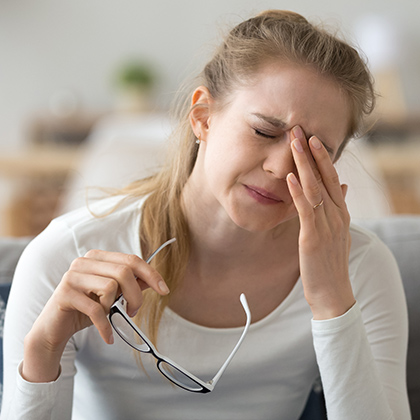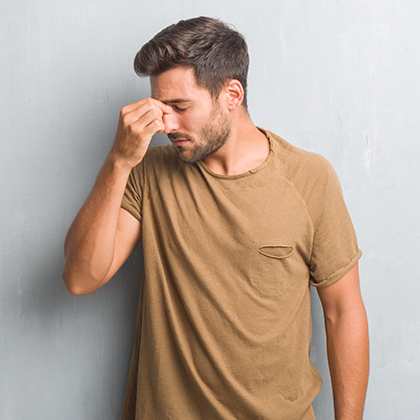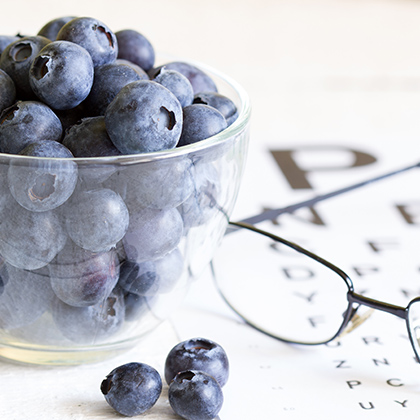
Whenever you leave a dark room and walk directly into bright sunlight, there’s a good chance you’ll experience photophobia, albeit momentarily.
Photophobia, despite the name, it isn’t an actual phobia. It’s actually a sensitivity to light that can make you squint, put your hand over your eyes to shade them, or even close your eyes altogether in bright light. However brief the experience (acute photophobia), it can make your eyes feel uncomfortable, or even painful.
Some, however, experience photophobia when exposed to relatively low levels of light, which don’t cause a problem in others. Also known as disability glare, this too causes pain or discomfort and can be very frustrating. This type of chronic photophobia is often experienced by people with other eye conditions, including:
-
Uveitis and iritis (inflammation affecting the middle layer of the eye)
-
Ocular albinism (lack of pigment in the eye)
-
Detached retina
-
Conditions affecting the surface of the front of the eye, such as dry eye, conjunctivitis, and problems with the cornea (the outermost transparent layer of the eye).
Other non-vision-related conditions are linked with photophobia too. These include meningitis, migraine, cluster headache, and trigeminal neuralgia (severe facial pain). Light sensitivity may also affect people with certain mental health problems, including depression, anxiety, bipolar disorder and agoraphobia. Laser surgery or lens replacement surgery to improve your eyesight may also make your eyes more sensitive to light (though this is usually temporary).
Certain medicines have also been found to cause photophobia, including the antibiotics tetracycline and doxycycline, as well as digitalis and quinine.
What happens in the eye?
Our vision works when light enters the eye is received by the retina and is then converted into messages that are sent to the brain via the optic nerve. This light passes smoothly through to the retina because the eye structures are normally transparent. But some eye conditions can cloud this.
Like cataracts, for example. If you have a cataract your lens is cloudy rather than clear, making it more difficult for light to pass through. According to the RNIB people with cataracts often have trouble with light sensitivity because light passing through the lens becomes scattered, causing glare.

Despite photophobia being fairly common, the mechanisms that cause it, and the pain or discomfort associated with it, aren’t well known. Some people are affected by photophobia without any eye problems, or any of the other conditions it’s linked with.
For instance, getting older can make your eyes more sensitive to light, even without an underlying eye condition. If you have light-coloured eyes, your vision may be more sensitive to light than someone with dark-coloured eyes (a possible explanation is dark-coloured eyes have more light-protective pigment than light eyes).
How your lifestyle can help
If your eyes become sensitive to light it’s important to see your optician, as it could be a symptom of an undiagnosed eye condition. If your eye specialist discovers an underlying cause, treating it is usually an effective way to get relief (according to the Eyecare Trust, in many cases once the triggering factor is treated, photophobia disappears).i
Meanwhile, some of the other things you could try include the following:
Tackle dry eyes
A review of light sensitivity studies suggests dry eye syndrome is the most common cause of photophobia.ii If your eyes feel dry and uncomfortable and are also sensitive to light, there are several things you could do that may help.
For instance, try to drink plenty of fluids to prevent dehydration, use drops called artificial tears to keep your eyes lubricated and consider taking natural supplements that have been found to help with dry eye syndrome such as sea buckthorn oil and fish oils.iii iv You can find more advice about this here.
Take a break
Some people who use computers and other digital devices over long periods of time may experience symptoms of computer vision syndrome. This can include dry eyes and light sensitivity. One way to combat this is to take frequent breaks. Try following the 20-20-20 rule: take a 20-second break from your screen every 20 minutes, and look at something at least 20 feet away. Longer breaks will be even more beneficial, to give your eyes a good rest.
Boost your macular pigment
Other nutritional supplements that may help protect against photophobia include those containing lutein and zeaxanthin. These are found in a wide range of colourful plant foods such as green leafy vegetables, orange and yellow fruit and vegetables, as well as eggs. To find out more, read What Foods Contain Lutein and Zeaxanthin: Eating for Eye Health.
Lutein and zeaxanthin are found in high concentrations in the macula, a small area in the retina. They provide a yellow pigment that protects the macula by absorbing light from the sun and other light sources. In one small-scale study, taking lutein supplements was shown to boost macular pigment density in some people, and increased the amount of light needed to trigger their photophobia.v
Wear sunglasses
Tinted lenses successfully combat photophobia. Different coloured lenses may be more useful than others, depending on what’s making your eyes sensitive. Talk to your optician about sunglasses with yellow, red or blue tints that may help improve light sensitivity (your optician may use an instrument called an MRC Intuitive Colorimeter to find out which colour filter would be most helpful for you). According to the RNIB, you may need a pair for sunny days and another pair with a lighter tint for not-so-bright conditions.vi
Photochromic lenses may be helpful too, as they change colour depending on the light conditions. You could also try adding an anti-glare coating to your lenses. These may protect against glare caused by reflected light.
The RNIB also recommends getting frames that offer more coverage than standard sunglasses, such as wraparound frames that protect your eyes from light coming from the side as well as from the front.
However, try to avoid wearing dark-tinted lenses indoors, as it could make your eyes even more sensitive to light in the long term.
Manage migraines
Migraines are the most common neurological disorder to cause photophobia. Up to 80 per cent of people with migraine experience light sensitivity during an attack. In such cases, pink-tinted glasses may be worth trying.vii In one study a rose-coloured tint called FL-41 reduced the number of migraines in children by more than 50 per cent, with photophobia reduced between attacks too.viii
There are also several other natural remedies that may help alleviate migraines – read our migraine guide to find out more.
If you’re interested in discovering ways of keeping your vision as healthy as possible, there’s lots more helpful advice in the rest of our Vision Health Hub.
References:
-
Photophobia. Eye Care Trust. Available online: https://www.eyecaretrust.org.uk/view.php?item_id=97
-
Digre, K.B., Brennan, K.C. (2012). Shedding Light on Photophobia. J Neuroophthalmol. 32(1): 68–81. Available online: https://www.ncbi.nlm.nih.gov/pmc/articles/PMC3485070
-
Larmo, P.S., Jarvinen, R.L., et al. (2010). Oral sea buckthorn oil attenuates tear film osmolarity and symptoms in individuals with dry eye. J Nutr. Aug;140(8):1462-8. Available online: https://www.ncbi.nlm.nih.gov/pubmed/20554904
-
Rahul, B., Prachi, K., et al. (2013). A randomized controlled trial of omega-3 fatty acids in dry eye syndrome. Int J Opthalmol. 6(6):811-816. Available online: https://www.ncbi.nlm.nih.gov/pubmed/24392330
-
Wenzel, , et al. Macular pigment optical density and photophobia light threshold. Vision Res. (2006 Dec). 46(28):4615-22. Available online: https://www.ncbi.nlm.nih.gov/pubmed/17087988
-
Larmo, P.S., Jarvinen, R.L., et al. (2010). Oral sea buckthorn oil attenuates tear film osmolarity and symptoms in individuals with dry eye. J Nutr. Aug;140(8):1462-8. Available online: https://www.ncbi.nlm.nih.gov/pubmed/20554904
-
Choy, J.Y., et al. (2009). Usefulness of a photophobia questionnaire in patients with migraine. Cephalalgia. 29(9):953-9. Available online: https://www.ncbi.nlm.nih.gov/pubmed/19298545
-
Good, P.A., Taylor, R.H., Mortimer, M.J. (1991). The use of tinted glasses in childhood migraine. Headache. 31(8):533-6. Available online: https://www.ncbi.nlm.nih.gov/pubmed/1960058
Related Posts?
Disclaimer: The information presented by Nature's Best is for informational purposes only. It is based on scientific studies (human, animal, or in vitro), clinical experience, or traditional usage as cited in each article. The results reported may not necessarily occur in all individuals. Self-treatment is not recommended for life-threatening conditions that require medical treatment under a doctor's care. For many of the conditions discussed, treatment with prescription or over the counter medication is also available. Consult your doctor, practitioner, and/or pharmacist for any health problem and before using any supplements or before making any changes in prescribed medications.

Christine
Christine Morgan has been a freelance health and wellbeing journalist for almost 20 years, having written for numerous publications including the Daily Mirror, S Magazine, Top Sante, Healthy, Woman & Home, Zest, Allergy, Healthy Times and Pregnancy & Birth; she has also edited several titles such as Women’ Health, Shine’s Real Health & Beauty and All About Health.
View More



